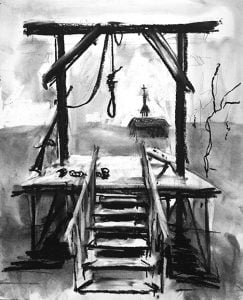A Thumbnail View of Abolition
Enslavement of Africans for labor in the New World began 500 years ago, shortly after European powers established colonies in the Caribbean, Mexico, and South America. From the beginning there were religious and moral objections, but the economic advantages of slavery in the conduct of mining and mass-produced agriculture (crops like tobacco, sugar, and cotton) prevailed.
The apologists for slavery invented theories that the slaves were somehow sub-human and could be treated as animals. These arguments carried over into the American colonies of England especially in areas where the slave-driven economy was booming. They were taught in schools, preached from pulpits, and eventually taken for granted by countless people.
Nevertheless opposition to slavery never died out. Quakers, Evangelicals, and Puritans offered early resistence. The Enlightenment of the 1700s with its focus on free thought and science gave rise to the Unitarian and Universalist churches which were markedly split on the issue of slavery and produced many leading abolitionists. The Declaration of Independence and the U. S. Constitution were both written largely by men who embraced Enlightenment ideals but even they had mixed feelings. Some, like Franklin and Hamilton, were outright abolitionists while others, like Jefferson and Madison, acknowledged the evil of slavery but put off dealing with its problems, wistfully assuming that it would die a peaceful death during the coming decades. Perhaps the most offensive and misguided words Jefferson ever wrote are in his 1781 book Notes on the State of Virginia where he vents his racist opinions of the intellectual incapacity and fundamental inferiority of African people.
Over the first seventy years of the United States the number of free states increased by 14 while the slave states added only 8. The strongly industrial economy of the North thrived on paid labor, while the invention of the cotton gin by Eli Whitney in 1793 made the creation of cotton fabric exponentially cheaper thereby creating a vast new market for cotton growers, a market that thrived on slave labor and thus created a demand for tens of thousands of new slaves annually. For a wealthy Southerner to oppose slavery was tantamount to embracing public disapproval ans economic suicide, so the majority of the South dug its heels deeper into the racist nonsense that most of its religious leaders had been preaching for decades and most of its newspapers published daily. Meanwhile the number of freed Blacks, primarily in the North, was growing rapidly and many of the Whites who had dealings with them realized how off-base their inherited prejudices had always been. These Whites, along with free Blacks, formed the core of the abolition movement that grew up until the time of the Civil War.
Illustration by Zoe McDonnell.

